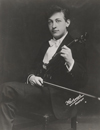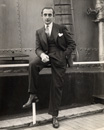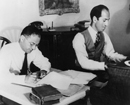All material found in the Press Releases section is provided by parties entirely independent of Musical America, which is not responsible for content.
Press Releases
Accademia Teatro alla Scala USA Tour 2018
ACCADEMIA TEATRO ALLA SCALA USA TOUR 2018
October 22, 2018 – 8 pm
UNIVERSITY OF MARYLAND - Clarice Smith Performing Arts Center
October 23, 2018 – 7.30 pm
PRINCETON UNIVERSITY - Richardson Auditorium
October 25, 2018 – 8 pm
NEW YORK - Peter Norton Symohony space
ACCADEMIA TEATRO ALLA SCALA ORCHESTRA
CONDUCTOR
IVÁN FISCHER
PRESS RELEASE
From 22nd to 25th October 2018 Iván Fischer, one of the most authoritative and acclaimed conductors in the world, gets on the podium of the Accademia Teatro alla Scala Orchestra for a series of concerts in the United States, promoted, under the patronage of Embassy of Italy and the Italian Cultural Institute in Washington, by the Milan per la Scala and UBI Banca, in collaboration with the American Society of Friends of Teatro alla Scala. The concerts, hosted at the Clarice Smith Performing Arts Center of the University of Maryland, at the Richardson Auditorium of the University of Princeton and at the Peter Norton Symphony Space in New York, are born as an opportunity to meet and exchange with major universities and musical institutes of the East Coast. The concerts are in fact open to young American students of the most important centers of study and specialization in the performing arts, called to meet their colleagues overseas with the aim of establishing a fruitful dialogue in the name of shared passion for music and for culture. Leading the orchestral formation of the La Scala Academy, consisting of more than seventy young under30 from three different continents, a director like Iván Fischer, regularly present in Europe, not only on the podium of the Budapest Festival Orchestra he founded, but also of the Berliner and of the Royal Concertgebouw Orchestra of Amsterdam. Fischer boasts an election relationship with the United States, having long conducted the National Symphony Orchestra of Washington DC, as well as being a frequent guest of major orchestras such as the New York Philharmonic or the Cleveland Orchestra. The program that the Maestro has chosen for the students of the Academy wants to be a tribute to Italian and European culture in North America: the concerts open with the overture from La gazza ladra by Rossini, composer whose 150 this year is celebrated Anniversary of the disappearance, followed by the Symphony n. 4 in the major known Italian op. 90 by Mendelssohn-Bartholdy, and the Symphony n. 5 in E minor, op. 64 of Caikovskij. For the orchestra of La Scala Academy, which over two years carries out an intense artistic activity in prestigious theaters and in the context of important festivals in Italy and abroad, addressing the symphonic, opera and ballet repertoire under the aegis of directors of proven authority, this experience is an extraordinary opportunity for educational and professional growth, as well as an opportunity for discussion and exchange with other young musicians.
Under the Patronage of Embassy of Italy in Washington, Italian Cultural Istitute in Washington and Accademia Teatro alla Scala
Gioachino Rossini
Ouverture from La gazza ladra
Felix Mendelssohn-Bartholdy
Simphony n. 4 (Italiana) in A major, op. 90
_____________________ ….. ____________________
Pëtr Il'ic Cajkovskij
Simphony n. 5 in E minor, op. 64
ITALY-USA: A DIALOGUE THROUGH MUSIC
Gioachino Rossini was a child prodigy who won enthusiastic acclaim from audiences across Europe, a genius capable of writing an opera such as The Barber of Seville in just a few weeks, who then retreated into seclusion at the age of 37 and the height of his career, to dedicate himself to meditation—at times struggling with depression—and writing recipes, garnished with an occasional masterpiece such as Stabat Mater and Petite messe solennelle. La gazza ladra was written before Rossini’s retreat from public view and was one of his favorites. The composer wrote to his mother in 1817: “Dearest Mother, Let us rejoice, rejoice by God! My Gazza Ladra a huge success. I cannot recall such fanaticism. It begins with a symphony that is so divine that all were pleased. […] I was called to the stage to immense applause after the first act. […] if you only knew how many nights I spent at the table writing this opera […] but it is the most beautiful I have ever written.” Indeed, it was impossible not to be swept away by the powerful vitality of the music right from the first notes of the overture. Audiences were thrilled but also taken aback by Rossini’s nonconventional genius: to some it seemed outrageous to begin an opera with that disconcerting drum roll!
Felix Mendelssohn-Bartholdy’s brilliant career began under the best auspices. He was born into a wealthy Jewish family in Berlin who were quite diligent about providing their children with an education that included reading and writing, mathematics, Greek and Latin, French and English, drawing and dance. Showing exceptional musical talent at an early age, Felix and his sister Fanny were taught piano, violin, and voice. The social setting provided further stimuli. The circle of friends and relatives who frequently visited the Mendelssohn house included the philosopher and mathematician Moses Mendelssohn and the men of letters Friedrich Schlegel and Johann Wolfgang von Goethe. Felix also traveled extensively through his native Germany as well as to England and France, broadening his cultural horizons and becoming acquainted with great artists and their masterpieces. He was twenty-two when he finally set foot in Italy and began to take in the rich pageant of people and places. In a letter to his family from Venice in October 1830, he exclaims, “Italy finally! I have thought of it as the highest joy of my life ever since I have been able to think; now this joy has begun and I am reveling in it.”
This spirit gave birth to the idea of creating a symphonic work that would express his deep and rapturous experience of Italy. Several years would pass, however, before he was able to produce the first version of his ‘Italian’ Symphony, a work that would soon be one of the world’s best loved symphonic compositions. The listener will particularly appreciate the reference to Italy in the last movement: the Salterello (presto) evokes the homonymous folk dance typical of central Italy, characterized by an extraordinary rhythmic vitality and a passing veil of melancholy.
Cajkovskij had a very close bond with the United States. During his tour in 1891 he stated that “American life, the customs, habits, are quite original and interesting” and “the Americans are delicately discriminating” as regards art. He was pleasantly surprised to find out that his works were played more often in America than in Russia. He had noted that “at rehearsals, the musicians received me with great enthusiasm”. And this enthusiasm was more than justified in his magnificent Fifth Symphony; Cajkovskij was quite pleased to hear that is was regularly performed on American soil. The opening notes, carried by the clarinets accompanied by the strings, introduce the intimate and meditative atmosphere that pervades the entire work.
The winds provide emphasis and emotional engagement, their warm, expressive tones conveying Cajkovskij’s idea for his symphony: “total submission before fate”. Listen to the beautiful dialogue between the horn and the clarinet, then the oboe, then the bassoon, and finally with all the strings.
Cajkovskij loved Italy as much as he did North America. He visited Italy no fewer than nine times, and his letters and memoirs are filled with his love for this land. “The nature, climate, artistic wealth, and history of Italy that you encounter at every step all have an irresistible charm.” Cajkovskij’s Fifth Symphony is thus a very fitting culmination to this concert, a wonderful homage to Italian and European culture in North America.
Andrea Massimo Grassi
IVÁN FISCHER
Iván Fischer is the founder and Music Director of the Budapest Festival Orchestra. He is also the Music Director of Berlin's Konzerthaus and Konzerthausorchester. From 2018 he will be the Artistic Director of the Vicenza Opera Festival. In recent years he has also gained reputation as a composer, with his works being performed in the United States, the Netherlands, Belgium, Hungary, Germany and Austria. Iván Fischer has directed a number of successful opera productions. His “staged concerts” have been performed in Budapest, New York, Berlin, Amsterdam, London, Bruges and in the Abu Dhabi and Edinburgh Festivals. The BFO’s frequent worldwide tours, and a series of critically-acclaimed records released first by Philips Classics and later by Channel Classics, have contributed to Iván Fischer’s reputation as one of the world’s most visionary music directors. The Berlin Philharmonic has played more than ten times under Fischer’s baton, and he also
spends two weeks every year with Amsterdam’s Royal Concertgebouw Orchestra. He is also a frequent guest of the leading US symphony orchestras, including the New York Philharmonic and the Cleveland Orchestra. As a Music Director, he has led the Kent Opera and the Opéra National de Lyon, and was Principal Conductor of the National Symphony Orchestra in Washington DC. Many of his recordings have been awarded prestigious international prizes. He studied piano, violin, and later the cello and composition in Budapest, before continuing his education in Vienna and Salzburg where he studied conducting under Hans Swarowsky
and Nikolaus Harnoncourt. Iván Fischer is a founder of the Hungarian Mahler Society and Patron of the British Kodály Academy. He has received the Golden Medal Award from the President of the Republic of Hungary, and the Crystal Award from the World Economic Forum for his services in promoting international cultural relations. The government of the French Republic made him Chevalier des Arts et des Lettres. In 2006 he was honored with the Kossuth Prize, Hungary’s most prestigious arts award. In 2011 he received the Royal Philharmonic Society Music Award, Hungary’s Prima Primissima Prize and the Dutch Ovatie Prize. In 2013 he was accorded Honorary Membership to the Royal Academy of Music in London. In 2015, he was
presented with the Abu Dhabi Festival Award for Lifetime Achievement, and in 2016 he won the Association of Music Critics of Argentina’s award for Best Foreign Conductor.
ACCADEMIA TEATRO ALLA SCALA FOUNDATION
Accademia Teatro alla Scala is one of the world's foremost institutions in training for the full range of performing arts professionals, from artists to technicians and managers. Chaired by Alexander Pereira and managed by Luisa Vinci, the Academy boasts the finest instructors from Teatro alla Scala and the collaboration of preeminent experts in the field, all sharing the objective of transmitting the theatre’s inestimable cultural heritage and universally recognized artistic tradition to the coming generations. The historical nuclei around which the Academy has developed were the Imperial Regia Accademia di Ballo, today's Ballet School, founded in 1813 by Francesco Benedetto Ricci, the Scuola dei Cadetti della Scala, created in 1950 by Arturo Toscanini and reborn in 1997 as the Academy of Lyric Opera, and the Course for Set designers, founded in the 1970s by Tito Varisco to ensure the continuation of La Scala excellence in stagecraft. Training and professional development at the prestigious Milanese theatre has continued unabated since those illustrious beginnings. The progressive diversification of the curriculum led to the creation of the Schools, Training and Development Department in 1991 and the institution of the independent Fondazione Accademia Teatro alla Scala in 2001. In addition to Teatro alla Scala, founding members include the Region of Lombardy, the City of Milan, the Chamber of Commerce of Milan, Bocconi University, the Milan Polytechnical University, Fondazione Bracco and Fondazione Milano per la Scala. They are supported by a sizeable group of foundations, associations, businesses and individual patrons, as well as public institutions such as the Italian Ministry of Foreign Affairs, which provides scholarships for foreign students. The curriculum comprises four departments – Music, Dance, Stage Workshops, Management – with
some thirty courses and over one thousand six hundred students from every corner of the world: 800 for professional courses and 800 for beginning courses, seminars and internships. The teaching method is based on direct real-world experience, an intensive internship program, and "on-the-job" training: concerts, performances, exhibitions, and the Academy Project, an annual feature in the La Scala season program, constitute the proving grounds for all Accademia students both in and outside of Italy. The educational activities are complemented by other proposals in various areas: the Education and Outreach Area, which organizes workshops and teaching initiatives addressed to students and teachers in schools at all levels in order to spread knowledge of musical theatre and the professions associated with it, and the Cultural Cooperation Area, which exports the Accademia teaching method through international projects and collaborations to countries seeking to implement start-ups or permanent training programs at local theatres or performing arts institutions. These projects are funded by the European Union or by local government. Here are just a few of the countless great artists who have trained at the La Scala Academy: Roberto Bolle, Massimo Murru, Marta Romagna, Nicoletta Manni, Virna Toppi, Martina Arduino, Angelo Greco, Jacopo Tissi, Fabio Capitanucci, Giuseppe Filianoti, Anja Kampe, Carmen Giannattasio, Nino Machaidze, Anita Rachvelishvili, Nino Surguladze, Aya Wakizono, Pretty Yende. Without counting all the technicians who now work behind the scenes in the world's most prestigious theatres and
festivals.
ACCADEMIA TEATRO ALLA SCALA ORCHESTRA
The two-year program of the La Scala Academy Orchestra prepares young musicians for their future career by offering them thorough preparation in the symphonic, opera, and ballet repertoire with an intensive series of concerts in Italy and abroad. Under the guidance of the first chairs of the Teatro alla Scala Orchestra and eminent conductors, the students have the opportunity to perform at Teatro alla Scala, which not only features them each year in an opera on the season program, but also engages them in numerous ballet productions and concerts. The more recent operas and ballets performed on Piermarini’s stage include Così fan tutte, Le nozze di Figaro, L’occasione fa il ladro, L’italiana in Algeri, Don Pasquale, La scala di seta, A Midsummer Night’s Dream, Giselle, Onegin, Histoire de Manon, Il barbiere di Siviglia, Die Zauberflöte, Hänsel und Gretel, and Ali Baba and the Forty Thieves. This year, the Orchestra also accompanied the Bolshoi Dance Company in their performance at Teatro alla Scala. The Orchestra has performed in a long list of theatres, music societies, and international festivals, including the Bolshoi Theatre in Moscow, the Saint Petersburg Philharmonia, the Royal Opera House in Muscat, the Harris Theatre in Chicago, Strathmore Hall in Washington D.C., La Fenice in Venice, Teatro Massimo in Palermo, Teatro San Carlo in Naples, Teatro Petruzzelli in Bari, Teatro Bellini in Catania, the RAI Auditorium in Turin, the Ravello Festival, the Kissinger Sommer Festival, and the Wolfegger Festspiele. Eminent conductors have taken their turns on the podium: Yuri Temirkanov, Zubin Mehta, Fabio Luisi, Ádám Fischer, Christoph Eschenbach, Marc Albrecht, Vladimir Fedoseyev, Manfred Honeck, Roland Böer, Michele Mariotti, Gustavo Dudamel, Gianandrea Noseda, Stefano Ranzani, Ottavio Dantone, Giovanni Antonini, John Axelrod, Susanna Mälkki, Pietro Mianiti, Daniele Rustioni, David Coleman, and Mikhail Tatarnikov. The Orchestra has also accompanied soloists of the caliber of Lang Lang, Herbie Hancock, Alexei Volodin, Simon Trpceski, David Fray, Olga Kern, Miriam Prandi, Alessandro Taverna, and Giovanni Andrea Zanon.
ACCADEMIA TEATRO ALLA SCALA ORCHESTRA
First violins
Federica Severini**
Nicola Bossone
Giorgia Brancaleon
Ilaria Daga
Camilla De Giovanni
Daniele De Vecchi
Sofia Gimelli
Sawa Kuninobu
Mathilde Marsal
Hikaru Matsukawa
Valentina Mattiussi
Davide Moro
Martina Ricciardo
Second violins
Veronica Schifano*
Ilze Abola
Giuliana De Siato
Cristiana Franco
Arianna Giannecchini
Elena Gori
Felipe José Kopušar Prenz
Davide Navelli
Vanja Radlovacki
Isabella Scalera
Meagan Slattery
Violas
Francesco Scarpetti*
Alessandra Di Pasquale
Martina Iacò
Ester Maccarini
Lorenza Merlini
Stefano Musolino
Midoriko Ono
Teresa Robledo Risueño
Marco Scandurra
Cellos
Giulia Libertini*
Sofia Bellettini
Thomas Bertolotti
Genevieve Catherine Brothwood
Tazio Brunetta
Paola Curcio
Francesca Giglio
Double-basses
Francesco D'Innocenzo*
Daniele Arena
Riccardo Baiocco
Covadonga Perera García
Clara Pertierra Sánchez
Davide Polloni
Flutes
Pier Filippo Barbano*
Yuri Guccione
Ilaria Ronchi (ottavino)
Oboes
Charles Raoult-Graïc*
Carlo Ambrosoli
Clarinets
Giona Pasquetto*
Andrea Albano
Bassoon
Carlo Alberto Meluso*
Camilla Di Pilato
Horns
Konrad Markowski*
Mattia Battistini
Alessandro Marino
Fiorenzo Ritorto
Trumpets
Marco Vita*
Marco Marri
Trombones
Flavio Placidi*
Niccolò Serpentini
Riccardo Ceretta (bass trombone)
Tube
Andrés Alcaraz López
Timpani
Luca Viotto*
Percussions
Francesco Fiorante
Letizia Grassi
Francesco Macrì
Umberto Antonio Summa
* First Chairs
** Leader






 FEATURED JOBS
FEATURED JOBS

 RENT A PHOTO
RENT A PHOTO


